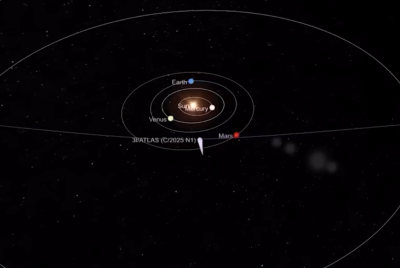New Cosmic Anomaly 100x Bigger Than 3I/ATLAS Poses Massive Threat
Sensational claims of a 'massive structure 100x bigger than 3I/ATLAS' arriving and targeting it have proliferated on social media and video platforms

In a captivating cosmic event shaking the astronomy world, the interstellar comet 3I/ATLAS emerged as a potential cosmic anomaly, fueling alien probe speculations amid its high-speed journey through our solar system.
Detected in 2025, this massive visitor boasts an estimated nucleus several kilometres across, dwarfing prior interstellar objects like Oumuamua and Borisov, with NASA and Hubble providing crucial size estimates and images.
While online rumors claim a 100x bigger structure poses a massive threat by targeting 3I/ATLAS, reputable sources confirm no evidence supports such dangers, highlighting instead its scientific value for understanding galactic origins.
Discovery and Trajectory of 3I/ATLAS
Astronomers first spotted 3I/ATLAS hurtling at 210,000 kilometres per hour, marking it as the third confirmed interstellar object to visit our solar system. Its perihelion, the closest point to the Sun, occurred on 29 October 2025, at approximately 1.4 astronomical units or 210 million kilometres.
The comet passed Mars on 3 October 2025 at 0.194 astronomical units, offering missions like HiRISE opportunities for detailed observations. It will reach its closest approach to Earth on 19 December 2025, at a safe 1.8 astronomical units or 270 million kilometres, posing no collision risk as affirmed by NASA.
This trajectory allows unprecedented study of its composition, with images revealing a surprising blue shine that has intrigued experts.
Size Estimates and Physical Anomalies
Hubble's sharp imaging enabled astronomers to estimate 3I/ATLAS' nucleus size at up to 15 kilometres in diameter, far larger than expected for typical comets. Further analysis pegs its mass at over 33 billion tons, deeming it 'anomalously massive' and challenging standard comet models.
Unusual nickel emissions detected defy physics norms, adding to its enigma as pointed out in an X Post.
🚨 New data from the Very Large Telescope just made 3I/ATLAS even weirder.
— Skywatch Signal (@UAPWatchers) October 1, 2025
It’s bleeding nickel at levels no comet should, defying physics, and dwarfing anything we’ve seen before, including Oumuamua and Borisov.
Let’s break down why this matters. 🧵👇 pic.twitter.com/QZ2cwyOBpP
Harvard astrophysicist Avi Loeb highlighted these behaviors, suggesting they 'might' indicate an artificial origin, though he stresses data limits rule out firm conclusions.
NASA, however, maintains it's a natural comet, with no radio signals detected despite searches. Post-perihelion data continues to refine these insights, enriching our knowledge of interstellar materials.
Speculations, Rumors, and Scientific Consensus
Sensational claims of a 'massive structure 100x bigger than 3I/ATLAS' arriving and targeting it have proliferated on social media and video platforms, often linked to unverified anomalies near the Sun or signals.
Such narratives, including a quote from Dr. Emily Carter stating 'This discovery challenges our previous notions of what we thought we knew about interstellar objects,' lack corroboration from credible outlets. Live Science and other experts dismiss alien tech links, affirming 3I/ATLAS resembles typical comets like C/2025 V1.
An X post from ORF notes early detection enables close study without interception needs. Balanced views underscore the importance of evidence over hype in cosmic research.
3I/#ATLAS, a newly detected interstellar object, is too fast to intercept, but early detection allows scientists to study it closely and learn more about its origin and makeup: @PrateekTri1990 https://t.co/sGt4fzh347
— ORF (@orfonline) November 15, 2025
The purported new anomaly is described in online videos as a colossal disc-shaped structure, captured in alleged footage from NASA's SOHO observatory on 27 March 2023, exhibiting perfect geometric symmetry with sharp, unyielding edges that appear engineered or mechanical against the Sun's plasma storms.
It is claimed to emerge suddenly and maintain a deliberate, steady position, defying solar winds and radiation that would disintegrate natural objects. Speculative theories portray it as potentially an interstellar energy-harvesting platform drawing power from the Sun or a surveillance hub monitoring Earth and inner planets, though experts dismiss these as entertainment fiction without empirical evidence.
© Copyright IBTimes 2025. All rights reserved.




















